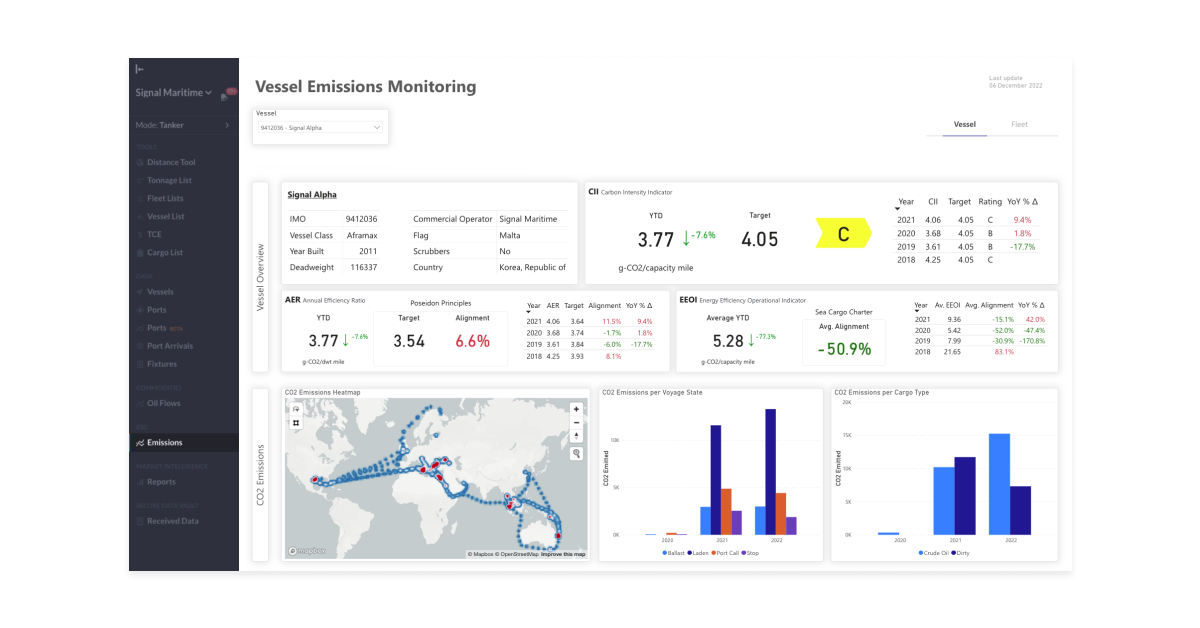Detailed back testing of actual CO2 emissions of circa 40 tankers that have been part of the Signal Maritime pool against Signal Ocean’s algorithm-based estimates has shown that real-time emission estimates are accurate within less than a 10% margin of error.
The power and simplicity of real-time emission estimates have been recently underlined in pretty much all of this year’s ESG fora, but accuracy is critical if owners, charterers and traders are to depend on them as a trustworthy indicator of a vessel’s CII (Carbon Intensity Indicator) rating in 2023 and beyond. The International Maritime Organization’s MARPOL Annex VI Carbon Intensity Indicator legislation takes effect from 1 January 2023.
With charterers now taking contractual responsibility for a vessel’s ship emissions under BIMCO’s new model CII clause, the need for real-time accurate CII assessments for any vessel based on its actual activity is critical. Whilst every vessel above 5000 GT will have a publicly available CII rating ranging from A to E, this rating will only describe a ship’s performance in the previous calendar year and not how it has performed so far this year, nor how it is likely to perform tomorrow or for the rest of the year.
The vessel emission features offered through the Signal Ocean platform, and the Vessel Emissions API allow shipping participants to see in a simple, systematic and consistent way emissions for any proposed voyage and enable meaningful benchmarking and comparisons.
Signal Ocean COO Dimitris Tsapoulis said:
“CII estimations for any vessel or voyage, past, current or future, allow Signal Ocean users to factor in environmental performance at the time they are weighing their chartering options. Anecdotally, traders using the service reported back accuracies that were very close to their own internal calculations, based on actual measurements; we were delighted to see yet another data point in Signal Maritime’s figures.”
He added:
“What is even more inspiring than seeing a system with high accuracy estimations is to see the Signal Maritime team producing top-of-class environmental performance by closely tracking and simulating it through data. Environmental performance will undoubtedly play an increasingly critical role in economic success as we approach 2030 and beyond.”
The Signal Ocean estimates vessel emissions, like CO2, from AIS data converted into voyages, where all stops for bunkering operations, idle times, repairs, loads and discharge operations are taken into account. At sea, ballast and laden legs and Sulphur Emission Control Area navigation times are clearly defined. Fuel consumption is mapped to different fuel types (VLSFO, MGO, HSFO) based on the area that vessels have been trading, as well as taking into consideration a rich set of vessel particulars, including dimensions, the country built, and year built, scrubber fitting, consumption curves, operational conditions and vessel speeds.
Earlier this year, the algorithm underpinning Signal Ocean's estimates of vessel CO2 emissions was verified as meeting IMO guidelines by the independent classification society DNV. The service is available for tankers, dry bulk and LPG vessels.
The opinions expressed herein are the author's and not necessarily those of The Xinde Marine News.
Please Contact Us at:
media@xindemarine.com


 Ningbo Containerized Freight Index Weekly Commentar
Ningbo Containerized Freight Index Weekly Commentar  Ningbo Containerized Freight Index Weekly Commentar
Ningbo Containerized Freight Index Weekly Commentar  Ningbo Containerized Freight Index Weekly Commentar
Ningbo Containerized Freight Index Weekly Commentar  BIMCO Shipping Number of the Week: Bulker newbuildi
BIMCO Shipping Number of the Week: Bulker newbuildi  Ningbo Containerized Freight Index Weekly Commentar
Ningbo Containerized Freight Index Weekly Commentar  Ningbo Containerized Freight Index Weekly Commentar
Ningbo Containerized Freight Index Weekly Commentar